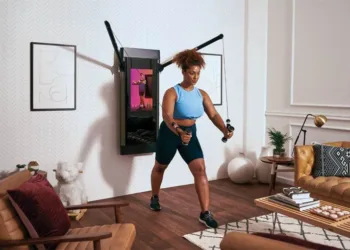My home is filled with smart gadgets, and I primarily control them through my smartphone. This reliance on a mobile device works well most of the time, as it’s always within reach—whether I need to turn on my smart lights, adjust my air purifier, or change the thermostat, I can usually handle these tasks with a few taps. However, having a physical button to execute these actions would be much more convenient. Instead of navigating through apps, having a simple remote would make things quicker and easier, similar to how one operates a television.
This is the idea behind the Linxura Smart Controller. This disc-shaped device allows you to perform numerous actions with just the press of a button. After connecting it to your smart devices, you can essentially ditch the companion apps. A simple tap or double-tap on its outer ring can activate a wide array of products. I’ve been trying it out at home, and while I find it to be an entertaining addition, it does have some shortcomings. However, if you’re looking for a physical remote for your smart home, this gadget is certainly worth considering.
Straightforward but Time-Consuming Setup

Linking smart devices with the Linxura Smart Controller is simple. Its e-ink display is sharp and clear, while the outer ring rotates and clicks, offering diverse ways to adjust your settings. You can connect it to your other smart devices using a process similar to setting up automations. For instance, after linking it to my Google Home account, I was able to create a program that lets me tap the outer ring to turn the lights on and double-tap to turn them off. The intuitive Linxura mobile app guides you through most of the steps, making it user-friendly for those unfamiliar with automations or routines.
This controller can map four devices to its four buttons, and the rotating ring allows you to navigate through 13 screens—providing ample space to assign your most frequently used actions.
While the setup is clear-cut, it can be incredibly time-consuming. Not only do you have to connect Linxura with each app, but you must also program every single action. This process can be quite lengthy and demands a fair bit of patience. Once configured, the e-ink screen displays icons and text that indicate what each button does, making it easy for other household members to understand which button to press.
Linxura has expanded its functionality since its launch in 2023, now supporting platforms like Google Home, Alexa, Yale, IFTTT, August, Philips Hue, and SmartThings. While there are some limitations in terms of functionality within these apps, all of the essential features are available. The compatibility with Google Home is particularly impressive, though the range of actions for some devices may not be as extensive as those found in their dedicated apps, meaning you might only be able to perform basic tasks like turning devices on or off.
A Good Fit for Many Smart Homes

Despite its few limitations, the Linxura Smart Controller could be a valuable addition to most smart homes. As long as you don’t need complex routines at the touch of a button, you’ll find it helpful. The convenience of having a physical button that allows anyone in the household to easily adjust the lights, stop a robot vacuum, or change the thermostat is undeniably beneficial.
I have noticed some lag in its performance, with certain actions taking a few seconds to register. For instance, switching on my lights can sometimes take nearly three seconds after pressing the button, and some users have reported even longer delays for other commands. While this isn’t a deal-breaker, it would certainly be preferable if communication between the Linxura and its connected devices were a bit more responsive.
Overall, I’ve found the Linxura to be a useful addition to my home setup. Its design may feel a bit bulky, but its buttons and spinning dial are enjoyable to use. Priced at $100, it is on the expensive side, but anyone looking for a fresh way to control their smart devices might find it to be an exciting addition to their home.









